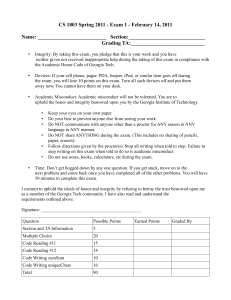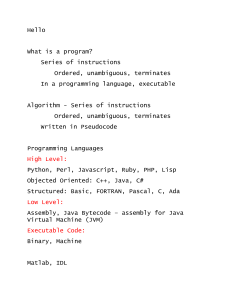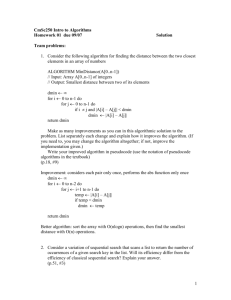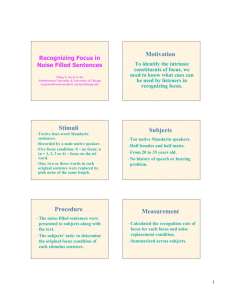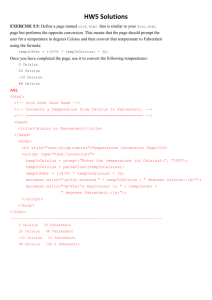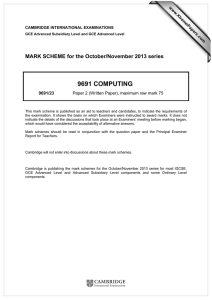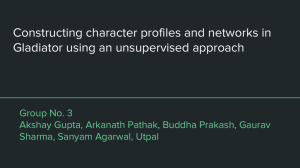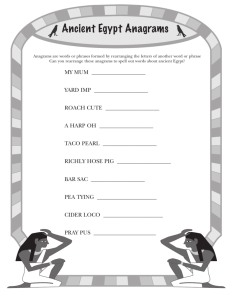CS 1803 Spring 2011 February 14, 2011 Exam 1 Name: _________________________________
advertisement
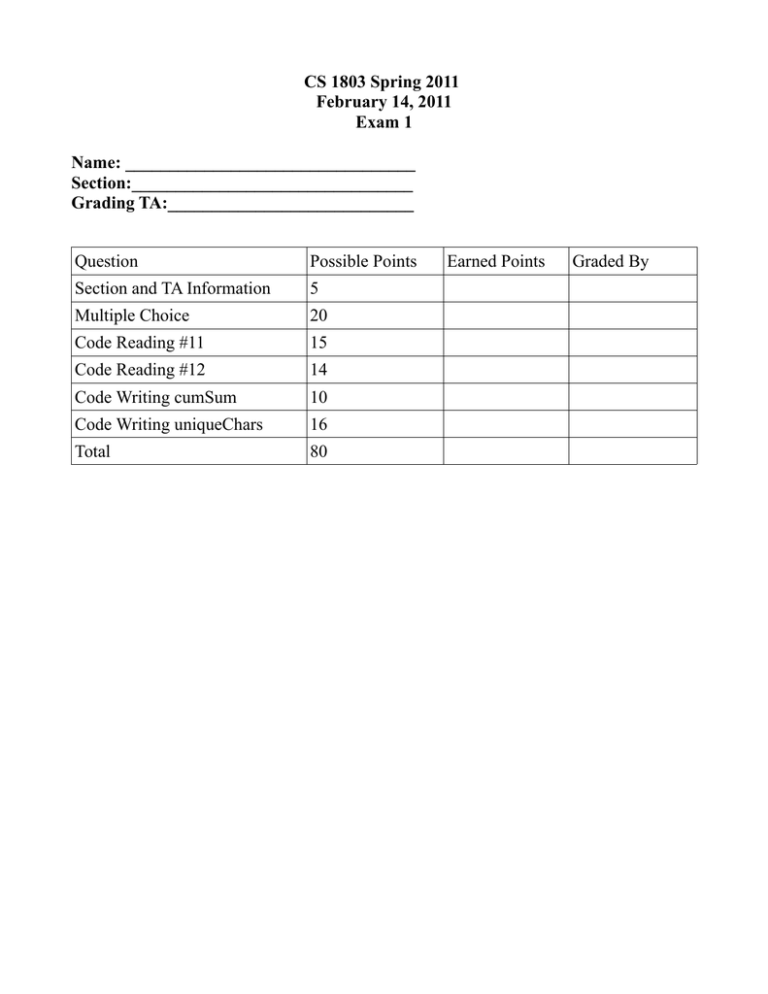
CS 1803 Spring 2011
February 14, 2011
Exam 1
Name: _________________________________
Section:________________________________
Grading TA:____________________________
Question
Possible Points
Section and TA Information
5
Multiple Choice
20
Code Reading #11
15
Code Reading #12
14
Code Writing cumSum
10
Code Writing uniqueChars
16
Total
80
Earned Points
Graded By
Multiple Choice- 20 points
Write your answers in the spaces below
1._______ 2._______ 3._______ 4._______ 5._______
6._______ 7._______ 8._______ 9._______ 10.______
1. An empty print statement print()
A. Returns a newline character ('\n')
B. Prints a newline character ('\n')
C. Both A and B
D. None of the above
2. Which index is out of range when fruits=['banana', 'apple']?
A. fruits[2]
B. fruits[-1]
C. fruits[-2]
D. all of the above
E. both A and C
F. both B and C
3. Which of the following are valid method headers?
A. def myFunc()
B. def myFunc(a,b):
C. def myFunc(a = 7)
D. myFunc():
E. both A and B
F. both B and C
4. myList = [0,1,2,3,4,5]
Which of the following lines of code will create a new list that has the elements of myList
reversed?
A. myList.reverse()
B. r = myList[::-1]
C. r = myList[-1:0:-1]
D. r = myList.flip()
5. For some number x, the following code will make at most
R
function call(s).
if x > 20:
some_func()
if x > 10:
some_func()
elif x > 7:
other_func()
elif x > 5:
another_func()
Q
function call(s) and at least
else:
pass
A. Q = 2, R = 0
B. Q = 3 , R = 0
C. Q = 4, R = 1
D. Q = 3, R = 1
6. Which of the following is not true about dictionaries?
A.Keys must be immutable
B.All entries are key:value pairs
C.Specific entries are accessed by index position
D. Defined with {}
7. a = return print(“CS IS FUN”)
What is the value of a?
A. there is no value because this code produces an error
B.“CS IS FUN”
C. print(“CS IS FUN”)
D. None
8. Which of the following are NOT true about conditional statements?
A. You can have unlimited elif per if
B. You can only have 1 else per if
C. Each If must have an elif or else
D. elif statements must specify a boolean expression
9. Given the following lines of code which statements are true?
for var in [4,12,28,9]:
print(var)
A.In the iterations var will equal 1,2,3,4 – in that order
B. In the iterations var will equal 4,12,28,9 – in that order
C.This loop prints 5 times
D. The same result/set of print lines could not be obtained with a while loop
10. To write a while loop that is not infinite you must:
A. specify a terminating condition
B. have a colon at the end of the while statement line
C. move towards the terminating condition in the loop
D. know how many iterations will be executed
E. A,B, and C
F. All of the above
Code Reading - 29 points
11. (15 points) After the following lines are executed, what is the value stored in each of the
variables?
A =[“CS”, “1803”, “is”, “so”, “fun!”]
B=A
C = B[ : ]
B[3] = A[4]
A = B[0:5:2]
D = C[0] + 3*C[1]
E=D
D = C[-1]
A=
B=
C=
D=
E=
Correct answers:
A ['CS', 'is', 'fun!']
B ['CS', '1803', 'is', 'fun!', 'fun!']
C ['CS', '1803', 'is', 'so', 'fun!']
D 'fun!'
E 'CS180318031803'
+3 for each correct answer
12. (14 points) Your friend is writing a program to see if one string can be created by rearranging
the characters in another string (regardless of capitalization), but it's not quite working.
def is_anagram(word1, word2):
# check that lengths are the same
if len(word1) != len(word2):
return False
# check that everything in word1 is in word2
for c in word1:
if c not in word2:
return False
#check that everything in word2 is in word1
for c in word2:
if c not in word1:
return False
return True
Provide the following to help your friend test the function:
(if such a pair does not exist, write “does not exist”)
*note: A pair of anagrams is a pair of strings that have all of the same letters but not necessarily
in the same order.
A pair of anagrams for which the function would return True
word1 = APPLE
word2 = PLEAP
A pair of anagrams for which the function would return False (a false negative result)
word1 = cs1803
word2 = 1803CS
*anything with different capitalizations
Why does the code return that they are not anagrams when they are?
The code is case sensitive so anything with different capitlaizations will be negative
A pair of non-anagram strings for which the function would return True (a false positive result)
word1 = AAAAAB
word2 = BBBBBA
Why does the code return that they are anagrams when they are not?
There are the same characters but not the same number of each one, and the code only
checks to see if the same characters are used regardless of the number of times
A pair of non-anagram strings for which the function would return False
word1 = BOBBY
word2 = BOB
grading:
+2 each for true returns that should be true and false that should be false
+3 each for false positive and false negative inputs
+2 each for explanation of false positive and negative
Code Writing (26 points)
13. Cumulative Sum (10 points)
Write a function named cumSum that takes in one parameter, a list of floating point numbers.
Your objective is to make a new list of the same length that has the cumulative sums from the
input list, meaning that the value at index 3 is the sum of the values in positions 0,1, 2 and 3.
Be sure not to alter the data in the original list, and return the new list of cumulative sums.
ex: cumSum([0,10,23,-9,3]) returns [0,10,33,24,27]
Sample Solution:
def cumSum(inList):
outList = inList[:]
for index in range(1,len(outList)):
outList[index] = outList[index] + outList[index-1]
return outList
+2 header and parameter
+2 make a new list that has the same length as the input
+2 loop through the list
+1 no indexing errors
+2 generate correct cumulative sums
+1 return the new list
14. Remove Duplicates (16 points)
Write a function named uniqueChars that takes in a string as a parameter. The purpose of the
function is to create a list of all the unique characters in the string in the order in which they
appear in the string parameter. For this question, an upper case character is the same as the
lower case character (so if you had the string "Abbbbba Baaaa", the resulting list would be ['A',
'b',' '], not ['A', 'b', 'a', 'B', ' ']); you must preserve the case of the first instance of the character in
your list. Once you have finished retrieving all the unique characters from the string, you
should return the list of unique characters.
Ex: uniqueChars("Hello World") returns ['H', 'e', 'l', 'o', ' ', 'W', 'r', 'd'].
SAMPLE SOLUTION:
def uniqueChars(string):
chars = []
for character in string:
if not ((character.upper() in chars) or (character.lower() in chars)):
chars.append(character)
return chars
GRADING RUBRIC:
+2 for correct function definition
+2 for declaring a list (somewhere)
+2 for declaring the list outside of the loop
+4 for checking to see whether or not the character exists in the list already before attempting to adding
+2 if case is successfully ignored
+3 for adding the character to the list
+1 for returning the list of characters
-2 for trying to .lower a list
-1 for not preserving capitalization when adding to result list
-2 for errors in looping.
